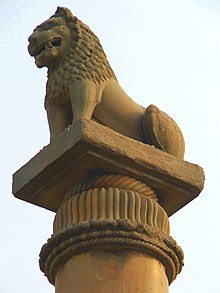describe the achievements of ashoka
The Edicts of Ashoka are a collection of 33 inscriptions on the Pillars of Ashoka, as well as boulders and cave walls, made by the Emperor Ashoka of the Mauryan dynasty during his reign from 269 BCE to 231 BCE. These inscriptions are dispersed throughout the areas of modern-day Bangladesh, India, Nepal and Pakistan and represent the first tangible evidence of Buddhism. The edicts describe in detail the first wide expansion of Buddhism through the sponsorship of one of the most powerful kings of Indian history. According to the edicts, the extent of Buddhist proselytism during this period reached as far as the Mediterranean, and many Buddhist monuments were created.
These inscriptions proclaim Ashoka's beliefs in the Buddhist concept of dharma and his efforts to develop the dharma throughout his kingdom. Although Buddhism and the Buddha are mentioned, the edicts focus on social and moral precepts, rather than specific religious practices or the philosophical dimension of Buddhism.
In these inscriptions, Ashoka refers to himself as "Beloved of the Gods" and "King Priya-darshi." The identification of King Priya-darshi with Ashoka was confirmed by an inscription discovered in 1915 by C. Beadon at Maski, the village in Raichur District of Karnataka State. The inscriptions found in the eastern part of India were written in the Magadhi language, using the Brahmi script. In the western part of India, the language used is closer to Sanskrit, using the Kharoshthi script, one extract of Edict 13 in the Greek language, and one bilingual edict written in Greek and Aramaic.These edicts were decodified by British archeologist and historian James Prinsep.
The inscriptions revolve around a few recurring themes: Ashoka's conversion to Buddhism, the description of his efforts to spread Buddhism, his moral and religious precepts, and his social and animal welfare program.



 Ashoka, the most trusted son of Bindusara and the grandson of Chandragupta Maurya, was a brave soldier. He was the most famous of the Mauryan kings and was one of the greatest rulers of India. During his father's reign, he was the governor of Ujjain and Taxila. Having sidelined all claims to the throne from his brothers, Ashoka was coronated as an emperor. Ashoka extended the Maurya Empire to the whole of India except the deep south and the south-east, reaching out even into Central Asia.
Ashoka, the most trusted son of Bindusara and the grandson of Chandragupta Maurya, was a brave soldier. He was the most famous of the Mauryan kings and was one of the greatest rulers of India. During his father's reign, he was the governor of Ujjain and Taxila. Having sidelined all claims to the throne from his brothers, Ashoka was coronated as an emperor. Ashoka extended the Maurya Empire to the whole of India except the deep south and the south-east, reaching out even into Central Asia. Under his reign
Under his reign  A similar four "Indian lion" Lion Capital of Ashoka atop an intact Ashoka Pillar at Wat U Mong near Chiang Mai, Thailand showing another larger Dharma Chakra / Ashoka Chakra atop the four lions.
A similar four "Indian lion" Lion Capital of Ashoka atop an intact Ashoka Pillar at Wat U Mong near Chiang Mai, Thailand showing another larger Dharma Chakra / Ashoka Chakra atop the four lions.  Ashokan Pillar at Vaishali
Ashokan Pillar at Vaishali